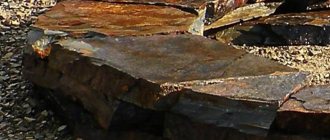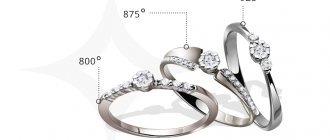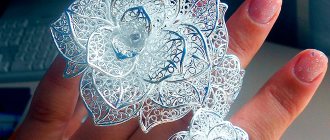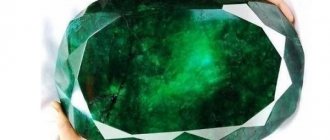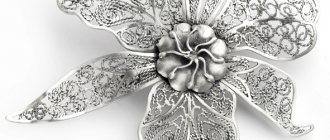You can see what grain is not only in museums, but also at exhibitions and art salons. This jeweler's technique, popular to this day, has been used in Russia for at least 12 centuries, as there are finds dating back to the 8th century AD. And abroad, even before our era, unique things were created using grain.
It is not at all difficult to determine exactly what granulation is - it is a method of artistic metal processing in which the smallest balls are made from it. These balls are then soldered to a metal base, creating a variety of patterns.
Another definition of what granulation is: decorating jewelry with the help of small metal balls, fastened in the form of an ornament on a metal base or complementing openwork filigree (patterns made of thin wire).
Russian grain
There is evidence that grain in Russia is perhaps even older than filigree. For example, medieval artifacts found in the Urals, dating back to the 8th century, contain grain. And filigree in this area appears only on objects from the 10th century.
Decoration from grain can be found on temple decorations, pendants, rings, rings, earrings, as well as scabbards and other rich household items found in treasures. The patterns were very expressive, with a special play of light and shadow. Complex compositions were created. One of the interesting options is to fasten grains in the form of pyramids, which were used to decorate the product.
Particular attention to the graining technique that existed in the 10th-14th centuries is associated not only with archaeological excavations and the study of ancient artifacts. Of course, there is interesting evidence about the skills of our ancestors, who knew what grain was in various regions of the country. But modern jewelers, in order to create new works of art, are interested in repeating unique, ancient technologies that made it possible to create real masterpieces.
Grain
Small balls of gold or silver (with a diameter of 0.4 mm), which are soldered onto filigree ornaments in jewelry. The grain creates an impressive play of texture, light and shadow, and introduces additional shades into the ornamental rhythm of the product.
The grain has been known since ancient times (in Mesopotamia, Ancient Greece, the Caucasus), became widespread in the Middle Ages (especially in Ancient Rus'), and is still used today.
A technique for making jewelry that involves soldering gold or silver grains onto an object (gold onto gold, silver onto silver).
The use of grain is very diverse: it can be scattered throughout the ornament, sometimes it borders parts of the object with stripes or is arranged as an independent ornament of rhombuses and triangles, and also forms relief pyramids and clusters.
The technique of making and fixing grain requires great skill, precision and patience from the master. In order to obtain a large number of grain balls of equal size, the master must first of all cut pieces of wire equal in length and diameter.
To speed up this process, the master winds the wire tightly around a cylindrical rod, and then cuts this spiral. The unclosed rings thus obtained, identical in size, are laid out with tweezers on a large piece of charcoal with rows of small depressions on it, after which a stream of flame is directed at them.
The molten rings in the form of drops roll into depressions made in the coal and solidify into balls. If a large number of balls are required, then the grain is obtained in a different way: rings or pieces of wire are not laid out on a piece of coal, but sprinkled with coal dust and melted in a crucible. The graining technique is almost inextricably linked with filigree.
On gold and silver jewelry of the 11th-12th centuries there are a variety of uses of grain. An ornament of triangles made of the finest grain adorns beads and acorn-shaped pendants on the gold temple ring with the figure of a “duck” from the Bulgarian collection, while the wings, chest and neck of the “duck” are completely covered with thin filigree rope.
Grain thickly covers silver star-shaped kolta of the 12th century from a treasure found in Vladimir. Individual shiny grains decorate three-bead temple rings of the 12th century with filigree ornaments from excavations in Kyiv. Up to the present day, grain serves as an invariable decoration and enrichment of filigree patterns of Russian jewelry.
How jewelry grain is made
Scientists believe that the methods of making grain have not changed over the centuries. The craftsmen knew several methods of creating it.
One of them is to pass a stream of molten gold or silver into the water through a filter. The result is a grain that is heterogeneous in shape and diameter.
When grain is produced from blanks of any kind (pieces, rings, grains), then these metal parts are straightened in powder obtained from charcoal. The result is standard size balls.
Blackening
Silver ring with blackening. Photo: valentin.livemaster.ru Bracelet made of blackened silver. Photo: www.diamondspearlsjade.com
The blackening technique is also a fairly old jewelry technique. The blackening composition is applied to the surface of the product in accordance with the design, then the black is melted in special ovens, forming a contrasting pattern. Each master has his own recipe for the mixture for blackening; the color and strength of the coating, its thickness and density depend on its composition.
Often, to give the ornament clarity and texture, filigree and grained products are blackened. Also, a three-dimensional design can be applied using the methods of hollowing, chasing, and engraving.
Among all metals, blackening of silver is the most common, since in this case the product not only acquires a richer and more noble appearance, but also becomes resistant to chemical and mechanical damage. Gold and platinum are used less frequently only due to the fact that it is almost impossible to remove high-quality niello from the surface in the future, and such jewelry can no longer be melted down.
We hope that you found the information interesting and useful. We also invite you to get acquainted with the complex, but increasingly popular, technique of working with metals - mokume gane, which originated in the 17th century in Japan.
Soldering - the mystery of grain
A question that is studied not only by historians, but also by specialists in the field of metallurgy, is how the grain was attached in a given case, since the soldering technique varied significantly among different craftsmen.
Connecting balls to each other or soldering granules to a base is a topic that has interested jewelers throughout the centuries. There were many special secrets in this technology. In some samples it is almost impossible to see how the ball is attached to the base.
Fine grain and filigree solder is a man-made miracle based on the properties of gold, silver and mercury. Jewelers made an amalgam of them, and then applied them to a ready-made pattern of filigree and grain. In a very heated object, mercury evaporated - and all parts were firmly connected to each other.
Techniques for laying filigree and grain differed in different territories. Historians study in detail not only what grain is, but also the differences in its production.
The secret of skillful soldering of filigree and grain products
One of the most important issues for a master scanner is the cleanliness of the solder, which should not fill small parts and thereby disrupt the clarity of the pattern.
On very ancient objects made of filigree and grain, the solder is so invisible that it seems as if some invisible glue is holding the individual parts together. Old Russian masters of filigree work also achieved great purity of work. This question has long been of interest to scientists and craftsmen from different countries. The famous Italian sculptor and jeweler of the 16th century, Benvenuto Cellini, dwells on it in detail in his treatise on jewelry; Many attempts to repeat the ancient originals with their inherent purity of work were made in different years by Western European scientists, but all were unsuccessful.
The lost secret of the ancient technique of invisible solder was revealed as a result of experiments conducted by Soviet researcher Professor F. Ya. Mishukov. He proved that instead of solder, ancient jewelers used an amalgam of gold, silver and mercury.
Sheets of thinly flattened so-called gold and silver leaf were ground in the proper proportion with a small addition of mercury to obtain an amalgam of the desired thickness. This amalgam was used to smear individual parts of the filigree ornament and balls of grain, after which the object was strongly heated. The mercury evaporated, and the parts of the ornament were firmly connected to each other.
Real and “false” grain
The grains are small balls that have been skillfully soldered. But the “grain”, which was obtained by casting in a special mold made for the entire decoration, is false grain. Of course, the cast filigree was just as false.
Cast jewelry was produced in the 12th and 13th centuries to simplify and speed up the process of making it. The craftsmen knew what filigree and grain were and knew the techniques for making them, but most likely there was a demand for cast products as well. Although the drawing, in comparison with real filigree and grain, became somewhat fuzzy.
Researchers studying and reconstructing the technology for making real grain suggest that the ancient master could not have time to make more than one earring with several beads in a week (summer, with long daylight hours). Such jewelry was very expensive.
History of the original decoration
This technique of applying ornaments was known back in 2000 BC. Its traces have been found on all continents of the globe. Since in ancient times the amount of gold was limited, jewelers tried to distinguish themselves not by the quantity of jewelry made, but by the quality and intricacy of the original patterns.
The most famous and striking example of products using granulation is Etruscan jewelry. This technology gained particular popularity in the territory of modern Tuscany in 700 BC. It differed from other types of decoration in its special elegance and complexity of execution. Not every master could boast of mastering this technique. The granulation technique was refined and popularized until 300 BC. With the advent of the Greek era and culture, it was undeservedly forgotten for many centuries.
In the territory of Ancient Rus' in the 9th – 12th centuries, jewelry with grains was also popular. Only high-ranking and status representatives of the wealthy class could afford such products. During this period of time it was often used with colored enamel
At the beginning of the 18th century, Italian jeweler Fortunatto Pio Castellani set out to revive ancient art in order to discover all the secrets of the ancient masters. In the 30s of the twentieth century, the English jeweler P. Littledale achieved maximum similarity in the technique of attaching grain with the works of the first masters. After which he received a patent for the unique subtleties of the matter that were revealed to him.

